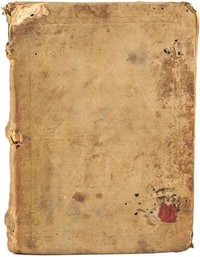Blind tooling is the most common decorative technique found on bindings up until the sixteenth century. A dark impression is made by impressing dampened leather with a heated brass finishing tool. The twelfth century saw an outpouring of creative blind tooling on leather book covers, and a number of these Romanesque bindings survive today, mostly in European libraries. This period of stamping with small decorative tools was short-lived, however, and most late medieval bindings were probably very plain, with any design limited to a few blind lines.
In the fifteenth century, with the increase in book production brought by the printing press, bookbinding became a viable commercial and secular enterprise. Binders acquired assortments of decorative stamps, which came to distinguish their work from that of other shops. These stamps, made of brass and mounted into wooden handles, produced a wonderful variety of shapes and images: birds and animals, flowers and intertwining leaves, human figures and abstract graphic forms. We see them used in combination with blind lines in various layouts, often associated with differing regional styles.
Swiss, fifteenth century
A typical late medieval monastic binding with only a few blind-tooled lines as decoration.
| Author: | Guillermus, Parisiensis |
| Title: | Postilla super epistolas et evangelia. |
| Published: | Basel: M. Furter, ca. 1497. |
| Location: | Rare Books: Incunabula Collection (ExI) |
| Call number: | 5268.419.1497 |
| Spine height: | 18 cm |
German, fifteenth century
A fifteenth-century south German binding in blind-tooled pigskin.
| Author: | Otto, von Passau, 14th cent. |
| Title: | Die vier vnd zwenzig Alten. |
| Published: | Strasbourg: Johann Schott, 1500. |
| Location: | Rare Books: Incunabula Collection (ExI) |
| Call number: | 5959.692 |
| Spine height: | 30 cm |
German, sixteenth century
German blind-tooled calfskin from the early sixteenth century. At this time books were not titled on the spine. The paper title pieces on this binding are a later addition.
| Author: | Morgenstern, Gergorius |
| Title: | Sermones contra omnem mundi perversum statum. |
| Published: | Strasbourg: Wilhelm procurator [Schaffrer] de Roperschwiler, 1513. |
| Location: | Rare Books (Ex) |
| Call number: | 2949.653.1513 |
| Spine height: | 19 cm |
Italian, sixteenth century
A sixteenth-century Italian binding in blind-tooled goatskin. The small knotwork stamp is very common on Italian bindings and reflects the influence of Islamic motifs.
| Author: | Villani, Giovanni, d.1348 |
| Title: | Croniche di Messer Giovanni Villani cittadino fiorentino. |
| Published: | Venice: Bartholomeo Zanetti, 1537. |
| Location: | Rare Books (Ex) |
| Call number: | Oversize DG737.A2 xV75 1537q |
| Spine height: | 32 cm |



